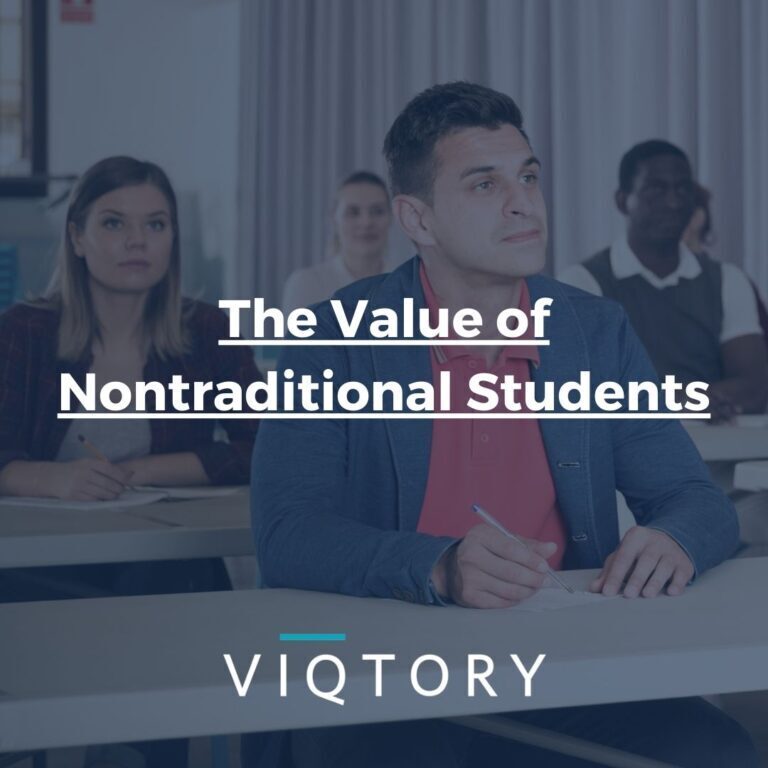Over the past few years, colleges and universities have put a focus on attracting more nontraditional students. When we say nontraditional students, we’re referring to individuals who didn’t graduate high school and go straight to college. They may be older, have families, work full or part-time, or have various other responsibilities that may make it difficult to take on a full course load.
Some of the different types of nontraditional students include:
- Adult Learners over the age of 25 who are returning to school
- Military Veterans pursuing higher education after the service
- Online Students who obtain their degrees completely online
- Working Students who attend school part-time
- Student Parents who are balancing family responsibilities & academic pursuits
- International Students
- Transfer Students
- And many more
Focus and Motivation
An increasing number of colleges and universities are interested in recruiting nontraditional students due to the wealth of benefits that these students offer an educational institution. For starters, these students tend to show up more focused and motivated than their traditional counterparts. They come with more real-world experience and more at stake than your typical high school graduate who is applying to schools because “it’s what you do after you graduate.” These folks tend to be goal-oriented and in pursuit of specific degrees, looking to change their career trajectories, better support their families, advance in their current careers, and improve their lives overall.
According to a report by the Lumina Foundation, nontraditional students make up a significant portion of the U.S. student population. In fact, 38% of all undergraduate students are over the age of 25, and 58% of all undergraduate students work while attending school. The proof is in the pudding. You don’t need to confine yourself to high school seniors and the traditional pool of potential students. The battle for admissions is real and it isn’t going away anytime soon. Rethink your plan of attack to include a larger, broader audience.
Diversity
In addition to being more motivated and focused, nontraditional students will help to diversify your classrooms and your campus. Coming from all different backgrounds, and bringing with them a variety of professional and personal life experiences will enrich classroom discussions and provide a more inclusive and comprehensive experience for all students. Recruiting students of all ages, ethnicities, backgrounds, and everything under the sun will help you to create a thriving melting pot of students, regardless of which type of institution you represent.
Untapped Market Potential
Last but most definitely not least, our nation’s nontraditional students are a virtually untapped market for colleges, universities, and even trade schools. Enrollments are declining and the competition is stiff when it comes to student recruitment, and as a result, schools need to adapt and key in on new methods for attracting students. It’s no exaggeration when we say that there are millions of potential students around the country, and the world, who would be categorized as nontraditional. If your school does not already have a plan to attract and recruit from this massive audience, you may be missing the boat.
Example
Here’s an example of a university that has laid the groundwork for success in attracting, recruiting, and retaining nontraditional students: Western Governors University (WGU) is an online university that caters to nontraditional students. So what does that look like? Not only are courses offered 100% online, but the university offers competency-based programs, meaning that students are able to move at their own pace and complete courses on their own schedule. They also offer a flat-rate tuition fee, meaning that instead of being charged per credit hour, you can take as many courses as you’d like at a fixed price. This allows students to tackle their personal responsibilities at home, at work, whatever it may be, while continuing to work towards a degree.
Conclusion
We know, not all colleges and universities are the same and what works for WGU may not be feasible at your school. The point is that they are making a concerted effort to attract, recruit, and cater to nontraditional students and they’re reaping the benefits. It is time for colleges and universities to recognize the value that nontraditional students bring to a campus, classroom, and student body.
You can fill out the form below if you’d like for information or if you’d like to discuss your school’s recruitment goals and initiatives.








